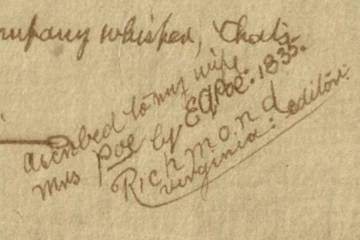A 124-year-old biscuit glued inside a soldier's scrapbook is among the treasures—and oddities—lining the shelves in the Library Services Center at Johns Hopkins. The lump of hardtack, a cheap, durable Army provision issued during the Spanish-American War, was meaningful enough for artillery soldier Henry Hyndman to keep in his personal collection, along with medals, newspaper clippings, letters, and other mementos spanning his young adulthood. Today his scrapbook survives among the stacks of Johns Hopkins Special Collections, nearby relics like the Hopkins Family Bible, a collection of letters and original works by Gertrude Stein, and research remnants of NASA's first mission to Mars.
In total, the Library Services Center—a climate-controlled, cavernous warehouse on a corner of the Applied Physics Laboratory campus in Laurel, Maryland—houses more than 20,000 boxes of artifacts owned by the Johns Hopkins University Sheridan Libraries, bits of university and Baltimore history mingling with thousands of assorted donated and curated collections. The items held within this facility number more than 2 million, primarily books and manuscripts but also photographs, artwork, films, university records, sheet music, newspapers, sports memorabilia, postcards, diaries, and more.
"I've been working here for 25 years and the bay still impresses me," says Dave Keifer, the library services manager who oversees the facility with his small team. "It's not just physically imposing—it gives off this weird monolithic energy."
The oldest artifact may be a Latin monograph from the 1500s, Keifer guesses. There are busts of famous figures from Johns Hopkins, as well as the bust of a deer. More than 1,500 boxes contain the papers of longtime Maryland Sen. Barbara Mikulski, dating back to her early days of activism on the Baltimore City Council. Thousands of VHS tapes and DVDs come from Video Americain, the local arthouse rental chain that survived until 2014, and a recent acquisition added thousands of vintage academic films.
View this post on Instagram
"Libraries are often asked why they keep what they keep. Simply put, libraries maintain history—whether that's the history of scholarship in a discipline or the history of an institution," says Elizabeth Mengel, associate dean for collections and academic services, who works closely with the Laurel team. "We believe that holding on to that history is important for education and for maintaining an informed and learned society."
In the Hopkins facility, there's the scrapbook and gold-tipped cane of Daniel Coit Gilman, the first president of Johns Hopkins University. There's a Benedict Arnold forgery. Within the Levy Sheet Music Collection, one can find early-20th-century songs from Pace & Handy Music Company, one of the first Black sheet music publishers in the country.
In collaboration with MICA, the warehouse also stores vintage advertisements from the Globe Printing Corp., a Baltimore institution for 81 years that promoted vaudeville, movies, carnivals, and later rock acts. "We have their old-fashioned Rolodex with famous people's names on it—so you run through it and see 'Brown, comma, James,' and his phone number," Mengel says.
Spread across thousands of boxes, the shelves also hold all of the administrative and departmental records relating to Johns Hopkins University's history, as well as those of some affiliated organizations, like the Space Telescope Science Institute, whose records include the planning of the Hubble telescope in the 1960s. "Keeping things like ephemera from a faculty member, such as a course syllabus from years ago, or documents from a student group, lets scholars see the context of the time, which helps them better understand decisions and actions that took place," Mengel says. "As librarians and archivists, we're always surprised at the twists and turns great research takes people. What started as an innocent piece of paper in an archival box just might spur the next big ideas."
Hopkins archivists on the Homewood campus are responsible for processing and organizing the archival items. In Laurel, Keifer's tight-knit team—library assistants John Bullock, Glenn Gonzales, and Rosemary Spellman—are maintain the trove of treasures, and is on hand to retrieve and send out materials to any researchers who request them—from an undergraduate completing a project to an author writing a book or a curator arranging an exhibit. Once you click "submit" on the library's website, the team helps by either scanning documents then emailing them on a 24-hour timeframe, or by delivering boxes within two days to researchers at different Hopkins libraries, via daily van trips.
Kept at 30% humidity at all times for preservation purposes, the massive storage space contains 12 rows of shelves, each towering 30 feet high, nearly touching the ceiling. Reaching the boxes on the higher shelves requires a hydraulic lift and tolerance for heights—a task usually reserved for Bullock, whose nickname is "The Boxman."
"There's a great system in place where we can request items to be sent from Laurel, and it happens quickly because of the phenomenal organization there," says Heidi Herr, librarian for English, Philosophy, and Special Collections Student Engagement.
The oldest materials generally fall under the domain of the Special Collections department and can be shipped out in containers to staff in that department, for use in a special reading room.
On average, the Laurel team fields about 140 requests per day. A while back, one biologist conducting field research on evolution in the Amazon only had brief access to the internet every two weeks—at which point he'd always request hundreds more reading materials. "That went on for several months," Keifer says. The team also recalls the researcher from Belgium who thanked them for their help by routinely mailing chocolates.
In addition to the original storage bay, built and opened in the early 2000s, another one equally large was recently constructed next door to store the contents of the Homewood campus' Milton S. Eisenhower Library when it undergoes a major renovation next year. Already, 400,000 items have been shipped to Laurel.
The archives collection also continues to grow as Hopkins librarians and curators add to it over time.
Herr, for example, recently amassed a cache of vintage board games, as well as a collection of romance comic books from the 1940s to 1970s.
She admits, though, that she's never actually seen the Laurel warehouse in person. That's true for many. For as vast and fascinating as its collections are, the place is tucked away quietly, a treasure chest you'd never know about if you weren't looking for it.
Posted in Arts+Culture
Tagged libraries, sheridan libraries, archives












